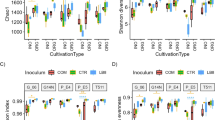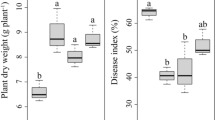Abstract
Lettuce plants respond differently to cover crop amendments by altering their biomass and nitrogen uptake (Nup) at different plant growth stages. Nonetheless, plant–microbe interactions involved in the alterations are scarcely studied. This study elucidated how the properties of the soil microbial community inhabiting the rhizosphere associated with lettuce (Lactuca sativa L. var. crispa “Red fire”) change during plant growth stages. Lettuce plants were cultivated in control soil and soil with rye, hairy vetch (HV), and rye plus HV (rye + HV) cover crop amendments. Rhizosphere soil samples were collected at the mid-growth and mature stages of plant development. DNA was extracted from the soil, and the 16S rRNA region was amplified using polymerase chain reaction to analyze bacterial genes and community structures and functions. Cover crop amendments and plant growth stages increased or decreased the relative abundances of bacterial taxa at the genus level. Plant maturity decreased 16S rRNA gene expression and the number of bacterial operational taxonomic units in all treatments. The unique, core, and shared taxa with low relative abundances may be associated with improved lettuce Nup and lettuce shoot and root biomass at each plant growth stage under different cover crop amendments based on multivariate analysis between plant indicators and bacterial genera groups. This study revealed the importance of bacterial groups with low relative abundance in plant–microbe interactions; such bacteria may promote the cover crop application for high lettuce productivity.





Similar content being viewed by others
Data Availability
The raw sequence data were submitted to the NCBI Sequence Read Archive (https://www.ncbi.nih.gov/sra) under BioProject accession PRJNA733680.
References
GP Brahmaprakash, PK Sahu, G Lavanya, SS Nair, VK Gangaraddi, A Gupta (2017) Microbial functions of the rhizosphere. In: Singh DP, Singh HB, Praba, R (eds) Plant–microbe interactions in agro-ecological perspectives. Springer, Singapore, pp 117–209. https://doi.org/10.1007/978-981-10-5813-4_10
Mendes R, Garbeva P, Raaijmakers JM (2013) The rhizosphere microbiome: significance of plant beneficial, plant pathogenic, and human pathogenic microorganisms. FEMS Microbiol Rev 37:634–663. https://doi.org/10.1111/1574-6976.12028
Wallenstein MD (2017) Managing and manipulating the rhizosphere microbiome for plant health: a systems approach. Rhizosphere 3:230–232. https://doi.org/10.1016/j.rhisph.2017.04.004
Schnepf A, He X (2021) Rhizosphere 5 - shining light on the world beneath our feet. Plant Soil 461:1–4. https://doi.org/10.1007/s11104-021-04942-9
P Nannipieri, J Ascher, MT Ceccherini, L Landi, G Pietramellara, G Renella, F Valori (2008) Effects of root exudates in microbial diversity and activity in rhizosphere soils. In: Nautiyal CS, Dion P (eds) Molecular mechanisms of plant and microbe coexistence. Springer, Berlin, Heidelberg, pp. 339–365. https://doi.org/10.1007/978-3-540-75575-3_14
van der Heijden MGA, Hartmann M (2016) Networking in the plant microbiome. PloS Biol 14:e1002378. https://doi.org/10.1371/journal.pbio.1002378
Jones P, Garcia BJ, Furches A, Tuskan GA, Jacobson D (2019) Plant host-associated mechanisms for microbial selection. Front Plant Sci 10:862. https://doi.org/10.3389/fpls.2019.00862
Buyer JS, Teasdale JR, Roberts DP, Zasada IA, Maul JE (2010) Factors affecting soil microbial community structure in tomato crop** systems. Soil Biol Biochem 42:831–841. https://doi.org/10.1016/j.soilbio.2010.01.020
Fernandez AL, Sheaffer CC, Wyse DL, Staley C, Gould TJ, Sadowsky MJ (2016) Associations between soil bacterial community structure and nutrient cycling functions in long-term organic farm soils following cover crop and organic fertilizer amendment. Sci Total Environ 566–567:949–959. https://doi.org/10.1016/j.scitotenv.2016.05.073
Manici LM, Caputo F, Nicoletti F, Leteo F, Campanelli G (2018) The impact of legume and cereal cover crops on rhizosphere microbial communities of subsequent vegetable crops for contrasting crop decline. Biol Control 120:17–25. https://doi.org/10.1016/j.biocontrol.2016.11.003
Maul JE, Buyer JS, Lehman RM, Culman S, Blackwood CB, Roberts DP, Zasada IA, Teasdale JR (2014) Microbial community structure and abundance in the rhizosphere and bulk soil of a tomato crop** system that includes cover crops. Appl Soil Ecol 77:42–50. https://doi.org/10.1016/j.apsoil.2014.01.002
Tian Y, Zhang X, Wang J, Gao L (2013) Soil microbial communities associated with the rhizosphere of cucumber under different summer cover crops and residue management: a 4-year field experiment. Sci Hortic 150:100–109. https://doi.org/10.1016/j.scienta.2012.10.025
Hoque MM, Ajwa H, Othman M, Smith R, Cahn M (2010) Yield and postharvest quality of lettuce in response to nitrogen, phosphorus, and potassium fertilizers. HortScience 45:1539–1544. https://doi.org/10.21273/HORTSCI.45.10.1539
Sapkota S, Sapkota S, Liu Z (2019) Effects of nutrient composition and lettuce cultivar on crop production in hydroponic culture. Horticulturae 5:72. https://doi.org/10.3390/horticulturae5040072
YD Chinta, Y Uchida, H Araki (2020) Availability of nitrogen supply from cover crops during residual decomposition by soil microorganisms and its utilization by lettuce (Lactuca sativa L.). Sci Hortic 270:109415. https://doi.org/10.1016/j.scienta.2020.109415
Buyer JS, Kaufman DD (1997) Microbial diversity in the rhizosphere of corn grown under conventional and low-input systems. Appl Soil Ecol 5:21–27. https://doi.org/10.1016/S0929-1393(96)00127-8
Oberholster T, Vikram S, Cowan D, Valverde A (2018) Key microbial taxa in the rhizosphere of sorghum and sunflower grown in crop rotation. Sci Total Environ 624:530–539. https://doi.org/10.1016/j.scitotenv.2017.12.170
Chen S, Waghmode TR, Sun R, Kuramae EE, Hu C, Liu B (2019) Root-associated microbiomes of wheat under the combined effect of plant development and nitrogen fertilization. Microbiome 7:136. https://doi.org/10.1186/s40168-019-0750-2
Liu L, Huang X, Zhang J, Cai Z, Jiang K, Chang Y (2020) Deciphering the relative importance of soil and plant traits on the development of rhizosphere microbial communities. Soil Biol Biochem 148:107909. https://doi.org/10.1016/j.soilbio.2020.107909
Farrar K, Bryant D, Cope-Selby N (2014) Understanding and engineering beneficial plant–microbe interactions: plant growth promotion in energy crops. Plant Biotechnol J 12:1193–1206. https://doi.org/10.1111/pbi.12279
Bonfante P, Anca I-A (2009) Plants, mycorrhizal fungi, and bacteria: a network of interactions. Annu Rev Microbiol 63:363–383. https://doi.org/10.1146/annurev.micro.091208.073504
V Nihorimbere, M Ongena, M Smargiassi, P Thonart (2011) Beneficial effect of the rhizosphere microbial community for plant growth and health. Biotechnol Agron Soc Environ 15:327–337. https://popups.uliege.be/1780-4507/index.php?id=7578
de Vries FT, Wallenstein MD (2017) Below-ground connections underlying above-ground food production: a framework for optimizing ecological connections in the rhizosphere. J Ecol 105:913–920. https://doi.org/10.1111/1365-2745.12783
J Zhang, Y Luo (2017) Degree centrality, betweenness centrality, and closeness centrality in social network. Proceedings of the 2017 2nd International Conference on Modelling, Simulation and Applied Mathematics (MSAM2017). https://doi.org/10.2991/msam-17.2017.68
Wattenburger CJ, Halverson LJ, Hofmockel KS (2019) Agricultural management affects root-associated microbe recruitment over maize development. Phytobiomes J 3:260–272. https://doi.org/10.1094/PBIOMES-03-19-0016-R
Gobran GR, Clegg S (1996) A conceptual model for nutrient availability in the mineral soil-root system. Can J Soil Sci 76:125–131. https://doi.org/10.4141/cjss96-019
Bhattacharyya PN, Jha DK (2012) Plant growth-promoting rhizobacteria (PGPR): emergence in agriculture. World J Microbiol Biotechnol 28:1327–1350. https://doi.org/10.1007/s11274-011-0979-9
Duca D, Lorv J, Patten CL, Rose D, Glick BR (2014) Indole-3-acetic acid in plant–microbe interactions. Antonie Van Leeuwenhoek 106:85–125. https://doi.org/10.1007/s10482-013-0095-y
ME Kroeger, K Nüsslein (2019) Stable isotope probing–detection of active microbes in soil. In: van Elsas JD, Trevors JT, Rosado AS, Nannipieri P (eds) Modern Soil Microbiology. CRC Press, Boca Raton, FL, pp. 269–293. https://doi.org/10.1201/9780429059186
Wang P, Marsh EL, Ainsworth EA, Leakey ADB, Sheflin AM, Schachtman DP (2017) Shifts in microbial communities in soil, rhizosphere and roots of two major crop systems under elevated CO2 and O3. Sci Rep 7:15019. https://doi.org/10.1038/s41598-017-14936-2
Dayan E, Presnov E, Albright LD (2005) Methods to estimate and calculate lettuce growth. Acta Hortic 674:305–312. https://doi.org/10.17660/ActaHortic.2005.674.36
Godornes C, Leader BT, Molini BJ, Centurion-Lara A, Lukehart SA (2007) Quantitation of rabbit cytokine mRNA by real-time RT-PCR. Cytokine 38:1–7. https://doi.org/10.1016/j.cyto.2007.04.002
Caporaso JG, Kuczynski J, Stombaugh J, Bittinger K, Bushman FD, Costello EK, Fierer N, Peña AG, Goodrich JK, Gordon JI, Huttley GA, Kelley ST, Knights D, Koenig JE, Ley RE, Lozupone CA, McDonald D, Muegge BD, Pirrung M, Reeder J, Sevinsky JR, Turnbaugh PJ, Walters WA, Widmann J, Yatsunenko T, Zaneveld J, Knight R (2010) QIIME allows analysis of high-throughput community sequencing data. Nat Methods 7:335–336. https://doi.org/10.1038/nmeth.f.303
J Oksanen, FG Blanchet, M Friendly, R Kindt, P Legendre, D McGlinn, PR Minchin, RB O’Hara, GL Simpson, P Solymos, MHH Stevens, E Szoecs, H Wagner (2017) Package ‘vegan’. Community Ecology Package, Version 2.4–2. http://cran.r-project.org/web/packages/vegan/index.html. Accessed April 3, 2019
Clarke KR (1993) Non-parametric multivariate analyses of changes in community structure. Aust J Ecol 18:117–143. https://doi.org/10.1111/j/1442-9993.1993.tb00438.x
Love MI, Huber W, Anders S (2014) Moderated estimation of fold change and dispersion for RNA-seq data with DESeq2. Genome Biol 15:550. https://doi.org/10.1186/s13059-014-0550-8
Csárdi G, Nepusz T (2006) The igraph software package for complex network research. Inter J Complex Sys. http://igraph.org. Accessed September 10, 2019
Zhang X, Zhang R, Gao J, Wang X, Fan F, Ma X, Yin H, Zhang C, Feng K, Deng Y (2017) Thirty-one years of rice-rice-green manure rotations shape the rhizosphere microbial community and enrich beneficial bacteria. Soil Biol Biochem 104:208–217. https://doi.org/10.1016/j.soilbio.2016.10.023
MJ McBride, W Liu, X Lu, Y Zhu, W Zhang (2014) The family Cytophagaceae. In: Rosenberg E, DeLong EF, Lory S, Stackebrandt E, Thompson F (eds) The Prokaryotes. Springer, Berlin, Heidelberg, pp 577–593. https://doi.org/10.1007/978-3-642-38954-2_382
Zang X, Liu M, Fan Y, Xu J, Xu X, Li H (2018) The structural and functional contributions of β-glucosidase-producing microbial communities to cellulose degradation in composting. Biotechnol Biofuels 11:51. https://doi.org/10.1186/s13068-018-1045-8
Y Zhou, R Lai, W-J Li (2014) The family Solimonadaceae. In: Rosenberg E, DeLong EF, Lory S, Stackebrandt E, Thompson F (eds) The Prokaryotes – Gammaproteobacteria, 4th edn. Springer, Berlin, Heidelberg, pp 627–638. https://doi.org/10.1007/978-3-642-38922-1_373
Miransari M (2013) Soil microbes and the availability of soil nutrients. Acta Physiol Plant 35:3075–3084. https://doi.org/10.1007/s11738-013-1338-2
Windisch S, Sommermann L, Babin D, Chowdhury SP, Grosch R, Mordtalab N, Walker F, Höglinger B, El-Hasan A, Armbruster W, Nesme J, Sørensen SJ, Schellenberg I, Geistlinger J, Smalla K, Rothballer M, Ludewig U, Neumann G (2021) Impact of long-term organic and mineral fertilization on rhizosphere metabolites, root-microbial interactions and plant health of lettuce. Front Microbiol 11:597745. https://doi.org/10.3389/fmicb.2020.597745
Lee SA, Kanth BK, Kim HS, Kim T-W, Sang MK, Song J, Weon H-Y (2019) Complete genome sequence of the plant growth-promoting endophytic bacterium Rhodanobacter glycinis T01E–68 isolated from tomato (Solanum lycopersicum L.) plant roots. Korean J Microbiol 55:422–424. https://doi.org/10.7845/kjm.2019.9115
JI Baldani, L Rouws, LM Cruz, FL Olivares, M Schmid, A Hartmann (2014) The family Oxalobacteraceae. In: Rosenberg E, DeLong EF, Lory S, Stackebrandt E, Thompson F (eds) The Prokaryotes – Betaproteobacteria, 4th edn. Springer, Berlin, Heidelberg, pp 919–974. https://doi.org/10.1007/978-3-642-30197-1_291
Sanders ME, Benson A, Lebeer S, Merenstein DJ, Klaenhammer TR (2018) Shared mechanisms among probiotic taxa: implications for general probiotic claims. Curr Opin Biotechnol 49:207–216. https://doi.org/10.1016/j.copbio.2017.09.007
Cavaglieri L, Orlando J, Etcheverry M (2009) Rhizosphere microbial community structure at different maize plant growth stages and root locations. Microbiol Res 164:391–399. https://doi.org/10.1016/j.micres.2007.03.006
Breidenbach B, Pump J, Dumont MG (2016) Microbial community structure in the rhizosphere of rice plants. Front Microbiol 6:1537. https://doi.org/10.3389/fmicb.2015.01537
Awika HO, Mishra AK, Gill H, DiPiazza J, Avila CA, Joshi V (2021) Selection of nitrogen responsive root architectural traits in spinach using machine learning and genetic correlations. Sci Rep 11:9536. https://doi.org/10.1038/s41598-021-87870-z
Grover M, Bodhankar S, Sharma A, Sharma P, Singh J, Nain L (2021) PGPR mediated alterations in root traits: way toward sustainable crop production. Front Sustain Food Syst 4:618230. https://doi.org/10.3389/fsufs.2020.618230
Acknowledgements
We thank Dr. Yoshitaka Uchida in the Research Faculty of Agriculture, Hokkaido University, for his supervision during the experiments and his input to the manuscript. We also thank Prof. Sonoko Dorothea Bellingrath-Kimura from the Leibniz Center for Agricultural Landscape Research (ZALF) and Humboldt University for her critical comments prior to manuscript submission.
Funding
This research was funded by the Grant-in-Aid for Scientific Research of Japan (grant number 18H02310), provided by the Japan Society for the Promotion of Science (JSPS).
Author information
Authors and Affiliations
Contributions
All authors participated in the study conception and design. The research and data collection and analysis were performed by Yufita Dwi Chinta under supervision and validation of Hajime Araki. The original draft of the manuscript was prepared by Yufita Dwi Chinta, and all authors commented on previous versions of the manuscript. All authors read and approved the final manuscript.
Corresponding author
Ethics declarations
Ethics Approval
Not applicable.
Consent to Participate
Not applicable.
Consent for Publication
Not applicable.
Competing Interests
The authors declare no competing interests.
Supplementary Information
Below is the link to the electronic supplementary material.
Rights and permissions
Springer Nature or its licensor holds exclusive rights to this article under a publishing agreement with the author(s) or other rightsholder(s); author self-archiving of the accepted manuscript version of this article is solely governed by the terms of such publishing agreement and applicable law.
About this article
Cite this article
Chinta, Y.D., Araki, H. Cover Crop Amendments and Lettuce Plant Growth Stages Alter Rhizobacterial Properties and Roles in Plant Performance. Microb Ecol 86, 446–459 (2023). https://doi.org/10.1007/s00248-022-02090-w
Received:
Accepted:
Published:
Issue Date:
DOI: https://doi.org/10.1007/s00248-022-02090-w




